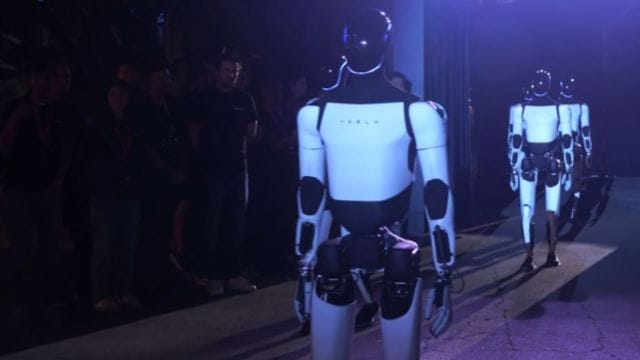© IE Online Media Services Pvt Ltd
Latest Comment
Post Comment
Read Comments
 Tesla's humanoid robots named Optimus walked out on their own at the company's 'We Robot' event. (Screenshot: Tesla)
Tesla's humanoid robots named Optimus walked out on their own at the company's 'We Robot' event. (Screenshot: Tesla)Tesla CEO Elon Musk has raised concerns about how much control or ‘influence’ he will ultimately have over the humanoid robots that the electric automaker is developing.
In an earnings call on Wednesday, October 22, Musk said that he felt uneasy about building a robot army without knowing if he could exert influence over them. “My fundamental concern with regard to how much voting control I have at Tesla is, if I go ahead and build this enormous robot army, can I just be ousted at some point in the future?” he said.
“If we build this robot army, do I have at least a strong influence over this robot army? Not control, but a strong influence […] I don’t feel comfortable building that robot army unless I have a strong influence,” the tech billionaire added.
Musk’s remarks come as Tesla shareholders gear up to vote on the board’s proposal to pay the CEO a staggering $1 trillion over the next 10 years. The vote is expected to take place in November this year.
If the deal is approved, Musk’s stake in Tesla would increase from 13 per cent to 25 per cent as long as he hits a series of ambitious goals outlined by the board. These targets include 20 million vehicles delivered, one million robotaxis in commercial operation, and an $8.5 trillion valuation.
Musk is also required to deliver one million Optimus humanoid robots if he wants to see a gigantic payday. It is well known that Musk’s immense wealth is closely tied to his more than 12 per cent stake in Tesla, whose rising valuation has been a key driver of his status as the world’s richest person.
The tech magnate, whose net worth reached $500.1 billion in October this year, also owns several other businesses including rocket company SpaceX, brain-computer interface developer Neuralink, social media platform X, and AI startup xAI. With regard to Tesla, Musk has always made it clear that he thinks of it as much more than an EV manufacturer.
On Wednesday’s call with investors, Musk said that Tesla’s robots would “actually create a world where there is no poverty, where everyone has access to the finest medical care.” It “will be an incredible surgeon, and imagine if everyone had access to an incredible surgeon.” For Tesla, Optimus will be “an infinite money glitch,” he added.
Elon Musk first revealed that Tesla would be developing humanoid robots during the company’s AI Day event back in 2021. As part of the announcement, a human dressed in a skin tight suit did a robot walk onstage which many found bizarre.
In 2022, Musk gave the public its first actual look at a bipedal Optimus prototype which was able to walk on stage and wave to the crowd. Several humanoid Optimus robots were seen walking out, serving drinks, and handing out gift bags to the attendees at Tesla’s ‘We Robot’ event held in October 2024. However, the humanoid robots were later acknowledged to be not fully autonomous but remotely operated by humans.
In more recent clips shared on social media, the humanoid robots can be seen serving drinks and popcorn, or entertaining visitors by dancing or playing rock, paper, scissors at the newly opened Tesla Diner in Los Angeles, United States.
Musk has always said he envisions the humanoid Optimus robots to have use cases beyond just industrial work. “Working will be optional, like growing your own vegetables, instead of buying them from the store,” he said in a post on X.
On the investor call, Musk reiterated that everyone will want a humanoid robot who can do their work for them. He has previously said that he expects each robot to cost somewhere between $20,000 to $30,000 in the long term.
However, Musk’s vision of a robotic future may still be a ways away. The company scaled down production plans of Optimus over the summer, according to a report by The Information. On Wednesday, Musk said Tesla would have a “production-intent prototype” ready by February or March next year, with full-scale production set to start at the end of 2026.